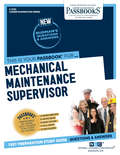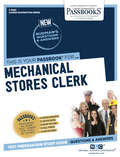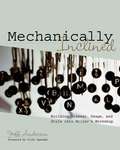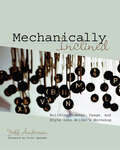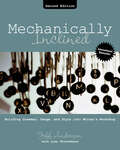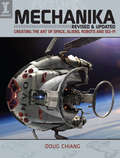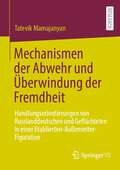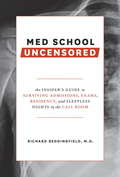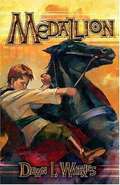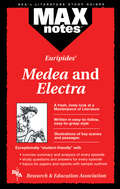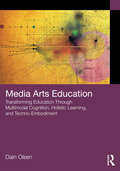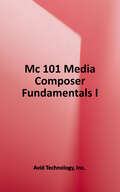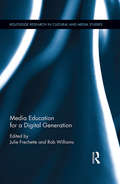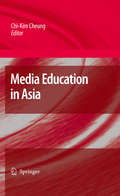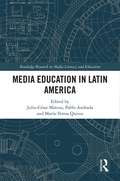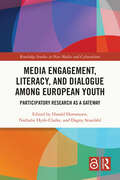- Table View
- List View
Mechanical Maintainer – Group C: Passbooks Study Guide (Career Examination Series #C-485)
by National Learning CorporationThe Mechanical Maintainer – Group C Passbook® prepares you for your test by allowing you to take practice exams in the subjects you need to study. It provides hundreds of questions and answers in the areas that will likely be covered on your upcoming exam, including but not limited to: Knowledge of operating, maintaining and repairing shop machines and equipment involving mechanical, electrical and plumbing work; Knowledge of safe working practices including use of scaffolds, ladders, and rigging; Knowledge of fire extinguishers; Knowledge of operation and maintenance of automotive vehicles; and more.
Mechanical Maintenance Supervisor: Passbooks Study Guide (Career Examination Series)
by National Learning CorporationThe Mechanical Maintenance Supervisor Passbook® prepares you for your test by allowing you to take practice exams in the subjects you need to study. It provides hundreds of questions and answers in the areas that will likely be covered on your upcoming exam.
Mechanical Stores Clerk: Passbooks Study Guide (Career Examination Series)
by National Learning CorporationThe Mechanical Stores Clerk Passbook® prepares you for your test by allowing you to take practice exams in the subjects you need to study. It provides hundreds of questions and answers in the areas that will likely be covered on your upcoming exam.
Mechanical and Electrical Systems for Construction Managers
by American Technical PublishersThis textbook is designed for general contractors, construction managers, and supervisors in the construction industry. This edition is organized into four parts: HVAC, Electrical, Plumbing, and Fire. It includes sustainable construction methods and energy efficiencies along with retrofitting of building automation systems.
Mechanical, Spatial & Abstract Reasoning
by Craig MackellarThis text provides an overview of key principles relating to mechanical, spatial and abstract thought. The aim is to facilitate the following learning outcomes. + Identify individual elements within a group of elements; + Identify a rule connecting a set of figures; + Complete a number of test questions by applying a rule connecting a set of figures; + Apply techniques aimed at increasing the speed at which logical rules are generated (the faster a person generates solutions, the higher the probability of a correct answer--in a given period of time); + Increase the number of elements a person can keep track of in responding to an item (span capacity). Someone with a larger span capacity than someone else can take into account more figures without making errors and hence has a larger probability of a correct answer. Mechanical, Spatial and Abstract Reasoning ability is a key element in identifying aspects of person's general intelligence. That is why the vast majority of psychometric tests will have a component that relates to abstract and spatial reasoning. This ebook will provide a measure of eductive ability or fluid intelligence which is relatively independent of specific learning acquired in a particular cultural or educational context.
Mechanically Inclined: Building Grammar, Usage, And Style Into Writer's Workshop
by Jeff AndersonMechanically Inclined is the culmination of years of experimentation that merges the best of writer's workshop elements with relevant theory about how and why skills should be taught. It connects theory about using grammar in context with practical instructional strategies, explains why kids often don't understand or apply grammar and mechanics correctly, focuses on attending to the "high payoff,” or most common errors in student writing, and shows how to carefully construct a workshop environment that can best support grammar and mechanics concepts. Jeff emphasizes four key elements in his teaching: short daily instruction in grammar and mechanics within writer's workshop; using high-quality mentor texts to teach grammar and mechanics in context; visual scaffolds, including wall charts, and visual cues that can be pasted into writer's notebooks; regular, short routines, like "express-lane edits,” that help students spot and correct errors automatically. Comprising an overview of the research-based context for grammar instruction, a series of over thirty detailed lessons, and an appendix of helpful forms and instructional tools, Mechanically Inclined is a boon to teachers regardless of their level of grammar-phobia. It shifts the negative, rule-plagued emphasis of much grammar instruction into one which celebrates the power and beauty these tools have in shaping all forms of writing.
Mechanically Inclined: Building Grammar, Usage, and Style into Writer's Workshop
by Jeff AndersonSome teachers love grammar and some hate it, but nearly all struggle to find ways of making the mechanics of English meaningful to kids. As a middle school teacher, Jeff Anderson also discovered that his students were not grasping the basics, and that it was preventing them from reaching their potential as writers. Jeff readily admits, “I am not a grammarian, nor am I punctilious about anything,” so he began researching and testing the ideas of scores of grammar experts in his classroom, gradually finding successful ways of integrating grammar instruction into writer's workshop. Mechanically Inclined is the culmination of years of experimentation that merges the best of writer's workshop elements with relevant theory about how and why skills should be taught. It connects theory about using grammar in context with practical instructional strategies, explains why kids often don't understand or apply grammar and mechanics correctly, focuses on attending to the “high payoff,” or most common errors in student writing, and shows how to carefully construct a workshop environment that can best support grammar and mechanics concepts. Jeff emphasizes four key elements in his teaching:short daily instruction in grammar and mechanics within writer's workshop;using high-quality mentor texts to teach grammar and mechanics in context;visual scaffolds, including wall charts, and visual cues that can be pasted into writer's notebooks;regular, short routines, like “express-lane edits,” that help students spot and correct errors automatically.Comprising an overview of the research-based context for grammar instruction, a series of over thirty detailed lessons, and an appendix of helpful forms and instructional tools, Mechanically Inclined is a boon to teachers regardless of their level of grammar-phobia. It shifts the negative, rule-plagued emphasis of much grammar instruction into one which celebrates the power and beauty these tools have in shaping all forms of writing.
Mechanically Inclined: Building Grammar, Usage, and Style into Writer's Workshop
by Jeff Anderson Lisa ThibodeauxSome teachers love grammar and some hate it, but nearly all struggle to find ways of making the mechanics of English meaningful to kids. As a middle school teacher, Jeff Anderson also discovered that his students were not grasping the basics, and that it was preventing them from reaching their potential as writers. Jeff readily admits, “I am not a grammarian, nor am I punctilious about anything,” so he began researching and testing the ideas of scores of grammar experts in his classroom, gradually finding successful ways of integrating grammar instruction into writer's workshop.Just in time for its 20th anniversary, this long awaited second edition of Mechanically Inclined continues to merge the best of writer's workshop elements with relevant theory about how and why skills should be taught. It connects theory about using grammar in context with practical instructional strategies, explains why kids often don't understand or apply grammar and mechanics correctly, focuses on attending to the “high payoff,” or most common errors in student writing, and shows how to carefully construct a workshop environment that can best support grammar and mechanics concepts. In this new edition, longtime colleague, Lisa Thibodeaux joins Jeff in emphasizing four key elements for grammar instruction: short daily instruction in grammar and mechanics within writer's workshop; using high-quality mentor texts to teach grammar and mechanics in context; visual scaffolds, including wall charts, and visual cues that can be pasted into writer's notebooks; regular, short routines, like “express-lane edits,” that help students spot and correct errors automatically. Comprising an overview of the research-based context for grammar instruction, a series of over forty detailed lessons, updated research, compelling new mentor texts, and an appendix of helpful forms and instructional tools, Mechanically Inclined is a boon to teachers regardless of their level of grammar-phobia. It shifts the negative, rule-plagued emphasis of much grammar instruction into one which celebrates the power and beauty these tools have in shaping all forms of writing.
Mechanik für das gymnasiale Lehramt: Theoretische Physik und mathematische Methoden klar erklärt
by Hendrik van HeesDieses Lehrbuch in drei Bänden führt in die Standardinhalte der Vorlesungen über Theoretische Physik (klassische Mechanik, Elektrodynamik und Quanten- und Relativitätstheorie) unter besonderer Berücksichtigung der speziellen Bedürfnisse von Lehramtsstudierenden ein. Im Vordergrund stehen dabei die grundlegenden Konzepte basierend auf Symmetrieprinzipien. Der vorliegende 1. Band behandelt die Newtonsche und analytische Mechanik. Besonderheiten Die konzeptionellen Grundlagen der klassischen Mechanik, insbesondere die mathematische Beschreibung von Raum und Zeit sowie der Begriff des Inertialsystems werden sorgfältig herausgearbeitet. Die für das Verständnis der theoretischen Physik unabdingbaren mathematischen Methoden werden parallel zu den eigentlichen physikalischen Lernhinhalten bereitgestellt und alle Rechnungen mit ausführlichen Zwischenschritten vollständig ausgeführt. Neben einer ausführlichen Behandlung der Newtonschen Mechanik mit den üblichen Beispielen zum freien Fall in Erdnähe, dem harmonischen Oszillator und dem Kepler-Problem der Planetenbewegung nimmt das Hamiltonsche Prinzip der kleinsten Wirkung und die ausführliche Behandlung der Symmetrieprinzipien und des Noether-Theorems einen breiten Raum ein. Dies ermöglicht ein vertieftes Verständnis für die moderne Beschreibung der Naturgesetze und erleichtert den Einstieg für die weiterführenden Vorlesungen beträchtlich, insbesondere der Quanten- und Relativitätstheorie. Inhalt 1. Kinematik und Dynamik der Newtonschen Mechanik und Erhaltungssätze, 2. Newtonsches Gravitationsgesetz und Himmelsmechanik, 3. Bewegung in beschleunigten Bezugssystemen, 4. Analytische Mechanik und das Noether-Theorem in Lagrangescher und Hamiltonscher Formulierung, 5. Anwendungen auf die Bewegung starrer Körper und Kreiseltheorie. Zielgruppe Das Buch richtet sich an Bachelor-Studierende der Physik und im Besonderen an Studierende der Physik für das Gymnasiallehramt. Dabei wird dem besonderen Bedarf dieser Zielgruppe einer möglichst einfachen Einführung in die mathematischen Methoden Rechnung getragen. Vorkenntnisse Vorausgesetzt werden Grundkenntnisse der Analysis, der linearen Algebra und der klassischen Mechanik und Eektrodynamik auf Abiturniveau.
Mechanika, Revised and Updated: Creating the Art of Space, Aliens, Robots and Sci-Fi
by Doug ChiangYou can design the future!In a post-apocalyptic alien landscape, starfighters crash land in desert terrain, dino riders rear up, rusted crab walkers litter the horizon and men work with--or fight against--giant iron robots. You control it all and Academy Award-winning sci-fi film production designer Doug Chiang tells you how. In this revised and updated version of his best-selling book, Mechanika, Chiang uses his 25 years in the film industry working on such films as the Star Wars franchise, Terminator 2: Judgment Day and War of the Worlds to teach you the techniques, tools and tips to draw and think like a master sci-fi artist.Inside you'll find:The six keys to good design and how to build an expert toolkit.Basic sketching techniques and the rules of perspective--even in imaginary worlds.25+ step-by-step demonstrations showing how to draw everything from monopods and labor beasts to aliens and steam-powered robots by mixing traditional drawing and marker techniques with digital painting technology.How to create compelling science fiction scenes inspired by movies, books, comics and games from conceptualization to completion.Tips and details on how to use Adobe Photoshop to design, draw and enhance your creations--including author secrets!Learn design secrets from one of the sci-fi artists behind Star Wars, War of the Worlds and Terminator 2: Judgment Day!
Mechanika: Creating the Art of Science Fiction with Doug Chiang
by Doug ChiangDelve into a world of imagination populated with giant robots, strange vehicles, alien creatures and other fantastic inventions. For generations artists have created imagery destined for the entertainment of others, and now you can too.Revered science fiction artist and film designer, Doug Chiang, reveals the thought processes and techniques he used working on blockbusters such as the Star Wars prequels, War of the Worlds, Terminator, and Beowulf. You'll learn from Chiang's visionary experience as he shares his design processes, giving expert advice and showcasing the groundbreaking style that has earned his creations a spot in the Brooklyn Museum, Houston Museum of Fine Art and the Tokyo National Museum.Inside you'll discover:30+ lessons for creating out-of-this-world science fiction scenes in the style featured in films, books, comics, toys and games using both traditional and digital techniquesDetails and tips for using Adobe Photoshop to conceive, design, draw and enhance your creations25 step-by-step demonstrations of outrageous robots, vehicles, creatures and environments with finished color imagesForeword by film producer/director Robert Zemeckis (Monster House, The Polar Express, Back to the Future, Beowulf)With tips on everything from basic skills like blueline sketching and assembling a toolkit to conceptualization and painting for digital art, Mechanika has everything you need to get great results and make your science fiction worlds come alive!
Mechanismen der Abwehr und Überwindung der Fremdheit: Handlungsorientierungen von Russlanddeutschen und Geflüchteten in einer Etablierten-Außenseiter-Figuration
by Tatevik MamajanyanDas vorliegende Buch befasst sich mit Umgangspraktiken mit Fremdheit aus der Perspektive von nach Deutschland zugewanderten Menschen aus zwei unterschiedlichen Migrationsphasen: Zugewanderte der 1990er Jahre und als Geflüchtete seit 2015 nach Deutschland zugewanderte Menschen. Latente Spannungen, Ängste, Konflikte, Ausgrenzungs- und Stigmatisierungsprozesse zwischen den früh und neu Zugewanderten deuten auf eine Etablierten-Außenseiter-Figuration zwischen den beiden genannten Zuwanderungsgruppen hin. Es wird gezeigt, dass die Beziehung zwischen den „etablierten Migrant*innen“ und den als Außenseiter stehenden Geflüchteten zum einen auf Prozesse deutet, dass und wie früh Zugewanderte zu „Einheimischen“ wurden und somit eine Phase des Fremdseins offenbar überwunden haben. Zum anderen deuten aktuell wahrnehmbare Vorurteile, Zuschreibungen und Rassismen von Zugewanderten der 1990er Jahre darauf hin, dass die eigenen Fremdheitserfahrungen in der Zeit des Ankommens in Deutschland nahezu verdrängt oder verdeckt wurden.
Mechatronics - Mechanical Engineering
by H. D. RamachandraMechatronics textbook is geared towards this focus and written for engineering students and for those wishing to gain a sound knowledge and understanding of the principles of mechatronics systems and engineering.
Med School Confidential: A Complete Guide to the Medical School Experience: By Students, for Students
by Robert H. MillerMed School Confidential from Robert H. Miller and Daniel M. Bissell uses the same chronological format and mentor-based system that have made Law School Confidential and Business School Confidential such treasured and popular guides. It takes the reader step-by-step through the entire med school process--from thinking about, applying to, and choosing a medical school and program, through the four-year curriculum, internships, residencies, and fellowships, to choosing a specialty and finding the perfect job. With a foreword by Chair of the Admissions Committee at Dartmouth Medical School Harold M. Friedman, M.D., Med School Confidential provides what no other book currently does: a comprehensive, chronological account of the full medical school experience.
Med School Uncensored: The Insider's Guide to Surviving Admissions, Exams, Residency, and Sleepless Nights in the Call Room
by Richard BeddingfieldAn entertaining insider's guide to the good, the bad, and the ugly of med school--with everything pre-med and med students need to know, from day one, to maximize opportunities and avoid mistakes.Cardiothoracic anesthesiologist and recent med school grad Dr. Richard Beddingfield serves as an unofficial older brother for pre-med and incoming med students--dishing on all the stuff he would've wanted to know from the beginning in order to make the most of med school's opportunities, while staying sane through the gauntlets of applying to and succeeding at med school, residency, fellowship, and starting work as a new physician. With advice from additional recent Ivy League med school grads and top-tier hospital residents, this all-in-one guide is a must-have for everyone who dreams of becoming a doctor.
Medallion
by Dawn L. WatkinsBefore taking his place as king of Gadalla, Trave, a young prince, must find a sacred medallion and ward off the forces of the Dark Alliance
Medea & Electra (MAXnotes Literature Guides)
by Tamara L. UnderinerREA's MAXnotes for Euripides' Medea & Electra MAXnotes offer a fresh look at masterpieces of literature, presented in a lively and interesting fashion. Written by literary experts who currently teach the subject, MAXnotes will enhance your understanding and enjoyment of the work. MAXnotes are designed to stimulate independent thought about the literary work by raising various issues and thought-provoking ideas and questions. MAXnotes cover the essentials of what one should know about each work, including an overall summary, character lists, an explanation and discussion of the plot, the work's historical context, illustrations to convey the mood of the work, and a biography of the author. Each chapter is individually summarized and analyzed, and has study questions and answers.
Medea (SparkNotes Literature Guide Series)
by SparkNotesMedea (SparkNotes Literature Guide) by Euripides Making the reading experience fun! Created by Harvard students for students everywhere, SparkNotes is a new breed of study guide: smarter, better, faster. Geared to what today's students need to know, SparkNotes provides: *Chapter-by-chapter analysis *Explanations of key themes, motifs, and symbols *A review quiz and essay topicsLively and accessible, these guides are perfect for late-night studying and writing papers
Media Arts Education: Transforming Education Through Multimodal Cognition, Holistic Learning, and Techno-Embodiment
by Dain OlsenThis book introduces and explains the emergent and dynamic discipline of media arts education and its potentials for educational transformation. Through an examination of its theoretical principles, holistic pedagogy, adaptive instructional practices, and diverse creative capacities, it demonstrates how media arts education can lead to a more student-centered, interdisciplinary, and effective educational model.Chapters combine academic research and practical examples to give an in-depth understanding of media arts education as it exists within schools today, as well as its potential for educational advancement. Author Dain Olsen provides an instructional framework for the discipline, including its history, research from cognitive and learning science, pedagogical principles, and examples of instructional practice. The book discusses how media arts education promotes active, multimodal and inquiry-based learning, constructivist methodology, and transdisciplinary integrations. Media arts affords students the ability to construct and simulate anything imaginable, supporting their self-directed creative inquiry. Not only can they create the myriad of artistic media, they can use it in representing and applying any core content so that it becomes aesthetically interactive, malleable and understandable. Later chapters include examples of media arts educator practices with lesson descriptions, project sequences, and instructional narratives. The book argues that media arts education can form a multimodal, interconnective, and adaptive educational system that is more empowering, engaging, flexible, and equitable for all students’ academic success.This resource is an essential companion for media arts educators at all levels. As it covers integration across a variety of contexts, it will additionally benefit educators in the fields of visual and performing arts, career technical education, media studies, computer science, and STEM and STEAM education.
Media Composer 101: Media Composer Fundamentals I
by Inc. Avid TechnologyMedia Composer 101: Media Composer Fundamentals I is an introductory book designed to get new users up and running quickly on Media Composer. <p><p>This book will teach you to edit a video project from start to finish using the same tools as Hollywood’s feature film editors. Learn to turn an interview into a compelling story, intercutting action footage with carefully selected sound bites. Use effects and sound editing to solve problems and give your video a professional polish. Plus, learn core technical skills such as how to input source video and audio files and export the finished sequence; identify Avid’s media storage locations and troubleshoot missing media. <p><p>Media Composer 101: Media Composer Fundamentals I is part of the Avid Learning Series and the official course book for MC101. When taken with the MC110 course, Media Composer Fundamentals II, this course is the first step to achieving the Avid Certified User designation.
Media Education for a Digital Generation (Routledge Research in Cultural and Media Studies)
by Rob Williams Julie FrechetteMedia education for digital citizenship is predicated upon the ability to access, analyze, evaluate and produce media content and communication in a variety of forms. While many media literacy approaches overemphasize the end-goal of accessing digital media content through the acquisition of various technology, software, apps and analytics, this book argues that the goals for comprehensive and critical digital literacy require grasping the means through which communication is created, deployed, used, and shared, regardless of which tools or platforms are used for meaning making and social interaction. Drawing upon the intersecting matrices of digital literacy and media literacy, the volume provides a framework for developing critical digital literacies by exploring the necessary skills and competencies for engaging students as citizens of the digital world.
Media Education in Asia
by Chi-Kim CheungMedia education in Asia is a relatively young, but rapidly developing part of the curriculum. Research has been conducted and papers have been written on various issues concerning media education in Asia. The dominant models of media education in the world are broadly Western and most are drawn from English-speaking countries. The question is whether a similar pattern exists in Asia, where there may be differences in culture, heritage, beliefs, values, education policy, as well as curriculum and pedagogy. Are educators in Asia following the Western model in developing and implementing media education, or are they devising their own models? With this question in mind, this book sets out to understand the prevailing perspectives regarding media education in various Asian societies. While most debates about media education are carried out in Western contexts, this book hopes to provide a platform for readers to examine this issue in an Asian context.
Media Education in Latin America (Routledge Research in Media Literacy and Education)
by Julio-César Mateus Pablo Andrada María-Teresa QuirozThis book offers a systematic study of media education in Latin America. As spending on technological infrastructure in the region increases exponentially for educational purposes, and with national curriculums beginning to implement media related skills, this book makes a timely contribution to new debates surrounding the significance of media literacy as a citizen’s right. Taking both a topical and country-based approach, authors from across Latin America present a comprehensive perspective of the region and address issues such as the political and social contexts in which media education is based, the current state of educational policies with respect to media, organizations and experiences that promote media education.
Media Education in the Primary School
by Carol CraggsMedia Education in the Primary School provides a clear, practical guide for teachers on how to approach media education. The author offers helpful advice on teaching about media institutions, news-gathering and on soaps, comics and advertising. Cross-cirucular classroom activities such as video-work, simulating advertising campaigns and photography are also included. All the activities have been thoroughly tested and are fully compatabile with current National Curriculum requirements.
Media Engagement, Literacy, and Dialogue among European Youth: Participatory Research as a Gateway (Routledge Studies in New Media and Cyberculture)
by Dagny Stuedahl Harald Hornmoen Nathalie Hyde-ClarkeMedia Engagement, Literacy, and Dialogue among European Youth explores young people’s participation in digital media spaces, drawing on participatory research methods to reflect with youth on how digital media is interwoven into their daily lives.Focusing on young people’s understandings of political and cultural exchanges, and what responses and actions they initiate, the book offers insight into their public engagement, digital media ethics, and an understanding of what capacities and challenges affect cultural dialogue and political participation. The chapters centre around case studies from Norway, Austria, and Germany, asking how young people use participatory media formats to display media literacy in relation to diversity, activism, and cultural dialogue. The chapters also include recommendations they have for building media literacy that advances engagement, creativity, and inclusiveness among youth.This book is intended for use in graduate courses, by doctoral students and the established research community and is freely available online on taylorandfrancis.com.The Open Access version of this book, available at http://www.taylorfrancis.com, has been made available under a Creative Commons Attribution-Non Commercial-No Derivatives (CC BY-NC-ND) 4.0 license.

